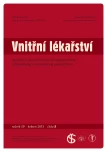Combined therapy of arterial hypertension
Authors:
H. Rosolová
Authors‘ workplace:
Centrum preventivní kardiologie II. interní kliniky Lékařské fakulty UK a FN Plzeň, přednosta prof. MU Dr. Jan Filipovský, CSc.
Published in:
Vnitř Lék 2013; 59(5): 366-369
Category:
Review
Overview
For a successful treatment of arterial hypertension, in most patients it is necessary to prescribe at least two antihypertensive medicines. A well chosen fixed combination of antihypertensives improves lifelong compliance with treatment, another important approach to improving treatment compliance being regular education of the patient regarding the appropriateness of regular medicine taking in relation to the risks of untreated hypertension. Currently, when initiating treatment of uncomplicated hypertension, the combination of diuretics with beta‑blockers is being abandoned, especially for their metabolic adverse effects. The most frequent combination of recommended antihypertensive medicinal products is a combination of renin‑angiotensin system inhibitors, i.e. ACE inhibitors or sartans, with calcium channel blockers or diuretics. Some studies about the efficacy of this modern combined antihypertensive therapy are mentioned.
Key words:
treatment of arterial hypertension – fixed combination – compliance with treatment – telmisartan – thiazide diuretics
Sources
1. Bangalore S, Kamalakkannan G, Parkar S et al. Fixed‑dose combinations improve medication compliance: a meta‑analysis. Am J Med 2007; 120 : 713 – 719.
2. Vrijens B, Vincze G, Kristanto P et al. Adherence to prescribed antihypertensive drug treatments: longitudinal study of electronically compiled dosing histories. BMJ 2008; 336 : 1114 – 1117.
3. Filipovský J, Widimský jr. J, Ceral J et al. Diagnostické a léčebné postupy u arteriální hypertenze – verze 2012. Doporučení České společnosti pro hypertenzi. Vnitř Lék 2012; 58 : 785 – 801.
4. Wald DS, Law M, Morris JK et al. Combination therapy versus monotherapy in reducing blood pressure: meta‑analysis on 11,000 participants from 42 trials. Am J Med. 2009; 122 : 290 – 300.
5. Dahlhof B, Sever PS, Poulter NR et al. Prevention of cardiovascular events with an antihypertensive regiment of amlodipine adding perindopril as required versus atenolol adding bendroflumethiazide as required, in the in the Anglo ‑ Scandinavian Cardiac Outcomes Trial – Blood Pressure LOwering Arm (ASCOT – BPLA): a multicenter rendomised controlled trial. Lancet 2005; 364 : 1 – 12.
6. Bakris G, Molitch M, Hewkin A et al. Differences in glucose tolerance between fixed‑dose antihypertensive drug combinations in people with metabolic syndrome. Diabetes Care 2006; 29 : 2592 – 2597.
7. Messerli FH, Makani H, Benjo A et al. Antihypertensive efficacy of hydrochlorothiazide as evaluated by ambulatory blood pressure monitoring: a meta‑analysis of randomized trials. J Am Coll Cardiol 2011; 57 : 590 – 600.
8. Dorsch M, Gillespie BW, Erickson SR et al. Chlorthalidone reduces cardiovascular events compared with hydrochlorothiazide: a retrospective cohort analysis. Hypertension 2011; 57 : 689 – 694.
9. Pfeffer MA, Swedberg K, Granger CB et al. Effects of candesartan on mortality and morbidity in patients with chronic heart failure: the CHARM ‑ Overall programme. Lancet 2003; 362 : 759 – 766.
10. Benson SC, Pershadsingh HA, Ho CI et al. Identification of telmisartan as a unique antagonist with selective PPAR gamma modulating activity. Hypertension 2004; 43 : 993 – 1002.
11. Schumacher H, Mancia G The safety profile of telmisartan as monotherapy or combined with hydrochlorothiazide: a retrospective analysis of 50 studies. Blood Press Suppl 2008; 1 : 32 – 40.
12. Abe M, Okada K, Maruyama T et al. Blood pressure lowering and antiproteinuric effect of switching from high‑dose ARBs to normal‑dose telmisartan and low‑dose hydrochlorothiazide in hypertensive patients with chronic kidney disease. Int J Clin Pharmacol Ther 2010; 48 : 206 – 213.
13. Barnett AH, Bain SC, Bouter P et al. Angiotensin‑receptor blockade versus converting‑enzyme inhibition in type 2 diabetes and nephropathy. N Engl J Med 2004; 351 : 1952 – 1961.
14. Neutel JM, Littlejohn TW, Chrysant SG et al. Telmisartan/ Hydrochlorothiatzide in comparison with losartan/ Hydrochlorothiazide in managing patients with mild ‑ to ‑ moderate hypertension. Hyperstens Res 2005; 28 : 555 – 563.
15. White WB, Lacourciere Y, Davidal G. Effect of the angiotensin II receptor blockers telmisartan versus valsartan on the circadian variation of blood pressure: impact on the early morning period. Am J Hypertens 2004; 17 : 347 – 353.
16. Marfatia R, White WB, Schumacher H. Effects of Telmisartan with Hydrochlorothiazide versus Valsartan with Hydrochlorothiazide in patients with moderate ‑ to ‑ severe hypertension. Intern J Hypertens 2012; doi:101155/ 2012/ 976828.
17. Yusuf S, Teo K, Pogue J et al. Telmisartan, ramipril, or both in patients at high risk for vascular events. N Engl J Med 2008; 358 : 1547 – 1559.
18. Masayoshi Kojima, Masuo Ohashi, Yasuaki Dohi et al. Titration of telmisartan, but not addition of amlodipin, reduces urine albumin in diabetic patients treated with telmisartan ‑ diuretic. J Hypertens 2013; 31 : 186 – 191.
Labels
Diabetology Endocrinology Internal medicineArticle was published in
Internal Medicine

2013 Issue 5
Most read in this issue
- Diastolic dysfunction in the elderly subjects. Disease or a physiological manifestation of ageing?
- Spondyloarthritides: Current Perspective on Diagnosis and Classification
- Comparison of MRCP a ERCP in Diagnosis of Choledocholithiasis
- Gluten induced diseases
